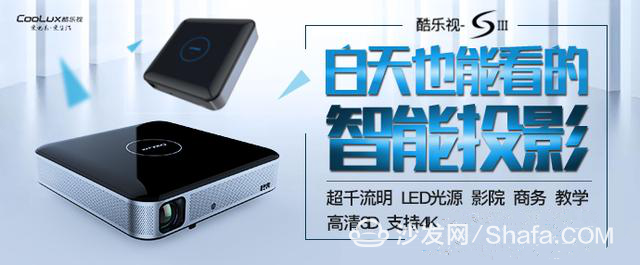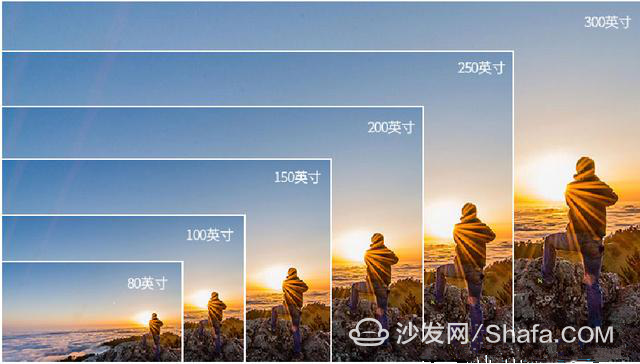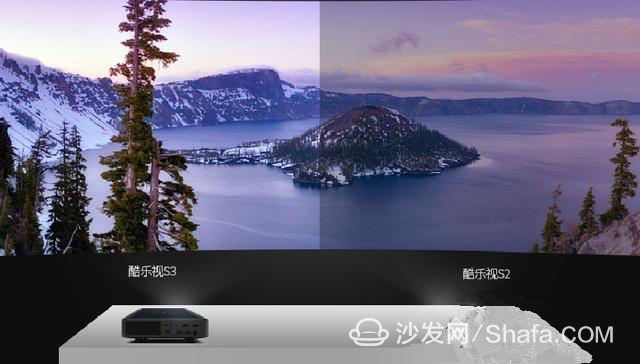With the continuous development of science and technology, not only display devices such as mobile phones, computers, and televisions, but also projectors have changed in the past and are bulky and have a single function. They have developed in the direction of intelligence and portability. Projection category - LED smart projector, the principle is to combine the large screen of the projector, the small and long life of the LED light source, and the Android smart system, trying to make the projector, which was originally only used as a "commercial education" product, to display at the consumer level. The market occupies the weight. In recent years, the development of LED smart projection has also won the popularity, market heat has increased year by year, but also into more and more people's homes, as a "home theater" like existence. However, many consumers find it not so good after using it. The main reason is that the brightness is too low to be seen during the day! So many high brightness can play a qualified "home theater" it, LED smart projection leader brand - cool music as proposed: more than 1000ANSI lumens, is the home theater performance dessert area!

SMPTE (American Animation and Television Engineering Association)

However, in a home environment, it is obviously impossible to achieve a completely dark environmental standard and it is not always to broadcast a movie. Therefore, the screen brightness requirement should be higher than that of a movie theater. In terms of experience, it is expected that at least 16fL to 24fL will be required. More suitable for home theater. This is the first and most important criterion for planning a home theater.
How big is the screen size?

In addition, we need to understand a parameter called "projection ratio", which will also affect the size of the screen. The smaller the projection ratio is, the larger the projection screen is at the same distance. Currently, the mainstream projections on the market are between 1.2-1.6, 1.2x projection. It takes 2.65 meters to shoot a 100-inch screen, and 1.6x requires 3.36 meters to shoot 100 inches. If you want to cast a larger screen, you need a deeper living room or room. Considering comprehensively, an experienced home theater enthusiast generally chooses a screen size of between 100 inches and 150 inches to ensure that the screen is large enough while having a good projection effect. It is not because of the large screen. Let the eyes and neck be too tired.
How does a 1000 ANSI lumen become a home dessert's performance dessert area?

1.1000ANSI lumens @ 100 inches
1 screen area calculation 100" (diagonal) = 86" x 48" = 28.64 square feet
2 divided by 1000 ANSI lumens by 28.64 square feet
1000/28.64 = 34.91fL
This means that the brightness projector will have 34.9 1FL "illuminance" over the area of ​​this size screen, which exceeds our selected 18fL ~ 24fL illumination range, which proves that even if the 1000ANSI lumen model is displayed on a 100-inch screen, Under bad conditions, it can also have a good display effect, but under full dark conditions, it is necessary to turn down the brightness, and for a general projector, lowering the brightness is only required by lowering the power, which is relatively easy to implement. But can you adjust the brightness? Under normal circumstances, the brightness of the machine is the highest brightness, the possibility of zero height adjustment. Of course, this situation also choose a gray screen with a gain of 0.9 to get a higher contrast picture.
2.1000ANSI lumens @123 inches
1 screen area calculation: 123" (diagonal) = 107" x 60" = 44.583 square feet
2 Divided by 1000 ANSI lumens by 44.583 square feet, 1000/44.583 = 22.43 FL
This means that the projector has an "illuminance" of 22.43FL on this size screen, which corresponds to the optimal illumination range of 16fL ~ 24fL that we have chosen. Can be extended, that is, this brightness can get a good display between 110-130 inches. Here you can also choose a white plastic curtain with a gain of 1.1 to get better color reproduction, soft light, and a large viewing angle.
3.1000ANSI lumens @ 150 inches
1 screen area calculation: 150" (diagonal) = 130" x 72" = 64.98 square feet
2 divided by 1000 ANSI lumens by 64.98 square feet, 1000/64.98 = 15.38 FL
It can be seen that the luminance projector is 15.38 FL "illuminance" on this size screen, which is slightly lower than the lower limit of the optimal illumination range of our set 16fL ~ 24fL. In other words, this brightness projection 150-inch screen, you want to get a better experience need to do a better light treatment (pull curtains, lights, etc.). Or choose a bead curtain with a gain of 2.5 to 2.8 to achieve a brighter picture.
Of course, brightness cannot be kept in the factory during the use of the product, we also need to consider the life of different light sources and light efficiency attenuation problems, generally believed that in the traditional 2-3000 hours of light bulb life, after reaching 50% of the life will be The beginning of the decline in light efficiency, and LED light source and laser light source life will be a lot of long-term, generally around 30,000 hours. But relatively speaking, LED projection is currently the only light source technology in the realization of ultra-thousand lumens: brightness, color, volume, longevity, reliability, cost advantages, is also becoming more choice for home projection users.
In fact, there is also a saying: "The higher the brightness, the better," but is it really true? We have all heard of a word called “That's too lateâ€. The projection is the same. When the brightness is too high, the dynamic contrast is likely to be lower. The light colors will be more clear in the dark, and the pure black and bright colors will have Loss, reduce the display effect. For commercial projector projections and engineering projections, the loss of these details is acceptable, but for a home theater projection it is not worth the benefit.
Finally, if you want to choose a home projector, it is recommended that you try to choose the projector with a brightness of over 1000 ANSI lumens, and Cool LeTV is a good choice as the world’s first ultra-thousands of lumens. LED smart micro-projection, Cool LeTV S3 not only has high brightness, configuration is also very versatile: 64-bit system A53 smart chip, 1280 × 800 (compatible 1080p, 2K4K), hivi Hivi hi-fi 8w2, auto focus / dynamic real-time focusing , innovative wall-mounted projection, DTMB digital television receiving system ..., from the picture quality, sound quality, content and then to the user experience over the previous generation products have increased over time, coupled with the pricing of 3,000 early, can be called the most cost-effective LED this summer Smart projection, no one.

For the brightness, the industry actually has a recognized best home projection brightness range: 1000-2000 ANSI lumens (real brightness), which is based on the family light environment, projection distance, service life, human eye comfort, screen display effects and other comprehensive considerations After the results, but in the end is how to calculate it? What data support?
SMPTE (American Animation and Television Engineering Association)

Since the ultimate goal of our projectors is to achieve near-cinema displays, we can directly refer to the “brightness†standard of cinemas. SMPTE (American Society of Motion Picture and Television Engineering) recommends values ​​12 to 16fL (foot Lambert). ), we can think of it as an imperial unit of brightness. Luminance can also be understood as: The "luminosity" emitted per square meter. It represents the significance of the optimal screen brightness that a movie theater needs to maintain while playing a movie, without the interference of external light sources like a movie theater. This is the value that SMPTE has been scientifically researched and has been adopted by cinemas worldwide. In short, this range is a moderate standard for an all-dark environment. When the brightness of the screen exceeds, the eyes will not be comfortable. When the screen brightness is lower than 12 fL, the screen will be too dark and it will look like no power!
However, in a home environment, it is obviously impossible to achieve a completely dark environmental standard and it is not always to broadcast a movie. Therefore, the screen brightness requirement should be higher than that of a movie theater. In terms of experience, it is expected that at least 16fL to 24fL will be required. More suitable for home theater. This is the first and most important criterion for planning a home theater.
How big is the screen size?

In order to achieve the optimal illuminance range emitted per square meter, we also need to confirm a suitable screen size. It can be understood that we do not achieve the best brightness performance after over or under a suitable size range.
In addition, we need to understand a parameter called "projection ratio", which will also affect the size of the screen. The smaller the projection ratio is, the larger the projection screen is at the same distance. Currently, the mainstream projections on the market are between 1.2-1.6, 1.2x projection. It takes 2.65 meters to shoot a 100-inch screen, and 1.6x requires 3.36 meters to shoot 100 inches. If you want to cast a larger screen, you need a deeper living room or room. Considering comprehensively, an experienced home theater enthusiast generally chooses a screen size of between 100 inches and 150 inches to ensure that the screen is large enough while having a good projection effect. It is not because of the large screen. Let the eyes and neck be too tired.
How does a 1000 ANSI lumen become a home dessert's performance dessert area?

Suppose we want to install a projector with a light output intensity specification of 1000 ANSI Lumen. We take three values ​​of 100â€, 123â€, and 150†from 100-150 inches, with the ratio of the conventional 16:9 projection screen. Luminance (fL) = lumens of the projector/area of ​​the screen (sq. ft.) * The gain of the screen (usually between 0.9 and 2.5) is calculated. Is the brightness of the screen within the range of 16fL ~ 24fL? ?
1.1000ANSI lumens @ 100 inches
1 screen area calculation 100" (diagonal) = 86" x 48" = 28.64 square feet
2 divided by 1000 ANSI lumens by 28.64 square feet
1000/28.64 = 34.91fL
This means that the brightness projector will have 34.9 1FL "illuminance" over the area of ​​this size screen, which exceeds our selected 18fL ~ 24fL illumination range, which proves that even if the 1000ANSI lumen model is displayed on a 100-inch screen, Under bad conditions, it can also have a good display effect, but under full dark conditions, it is necessary to turn down the brightness, and for a general projector, lowering the brightness is only required by lowering the power, which is relatively easy to implement. But can you adjust the brightness? Under normal circumstances, the brightness of the machine is the highest brightness, the possibility of zero height adjustment. Of course, this situation also choose a gray screen with a gain of 0.9 to get a higher contrast picture.
2.1000ANSI lumens @123 inches
1 screen area calculation: 123" (diagonal) = 107" x 60" = 44.583 square feet
2 Divided by 1000 ANSI lumens by 44.583 square feet, 1000/44.583 = 22.43 FL
This means that the projector has an "illuminance" of 22.43FL on this size screen, which corresponds to the optimal illumination range of 16fL ~ 24fL that we have chosen. Can be extended, that is, this brightness can get a good display between 110-130 inches. Here you can also choose a white plastic curtain with a gain of 1.1 to get better color reproduction, soft light, and a large viewing angle.
3.1000ANSI lumens @ 150 inches
1 screen area calculation: 150" (diagonal) = 130" x 72" = 64.98 square feet
2 divided by 1000 ANSI lumens by 64.98 square feet, 1000/64.98 = 15.38 FL
It can be seen that the luminance projector is 15.38 FL "illuminance" on this size screen, which is slightly lower than the lower limit of the optimal illumination range of our set 16fL ~ 24fL. In other words, this brightness projection 150-inch screen, you want to get a better experience need to do a better light treatment (pull curtains, lights, etc.). Or choose a bead curtain with a gain of 2.5 to 2.8 to achieve a brighter picture.
Of course, brightness cannot be kept in the factory during the use of the product, we also need to consider the life of different light sources and light efficiency attenuation problems, generally believed that in the traditional 2-3000 hours of light bulb life, after reaching 50% of the life will be The beginning of the decline in light efficiency, and LED light source and laser light source life will be a lot of long-term, generally around 30,000 hours. But relatively speaking, LED projection is currently the only light source technology in the realization of ultra-thousand lumens: brightness, color, volume, longevity, reliability, cost advantages, is also becoming more choice for home projection users.
In fact, there is also a saying: "The higher the brightness, the better," but is it really true? We have all heard of a word called “That's too lateâ€. The projection is the same. When the brightness is too high, the dynamic contrast is likely to be lower. The light colors will be more clear in the dark, and the pure black and bright colors will have Loss, reduce the display effect. For commercial projector projections and engineering projections, the loss of these details is acceptable, but for a home theater projection it is not worth the benefit.
Finally, if you want to choose a home projector, it is recommended that you try to choose the projector with a brightness of over 1000 ANSI lumens, and Cool LeTV is a good choice as the world’s first ultra-thousands of lumens. LED smart micro-projection, Cool LeTV S3 not only has high brightness, configuration is also very versatile: 64-bit system A53 smart chip, 1280 × 800 (compatible 1080p, 2K4K), hivi Hivi hi-fi 8w2, auto focus / dynamic real-time focusing , innovative wall-mounted projection, DTMB digital television receiving system ..., from the picture quality, sound quality, content and then to the user experience over the previous generation products have increased over time, coupled with the pricing of 3,000 early, can be called the most cost-effective LED this summer Smart projection, no one.
